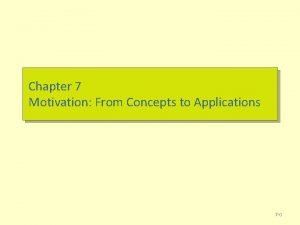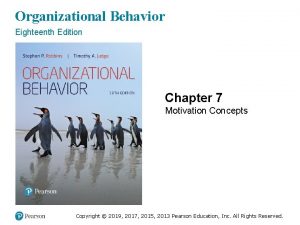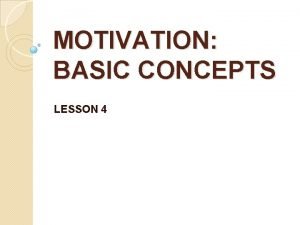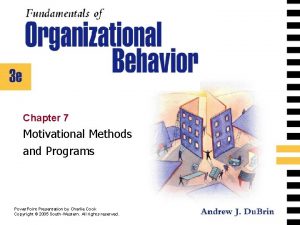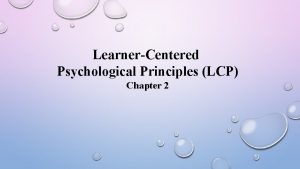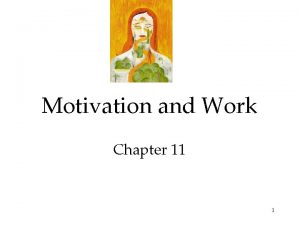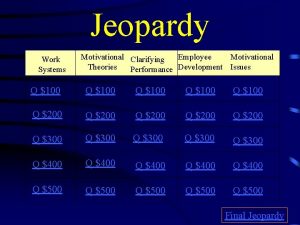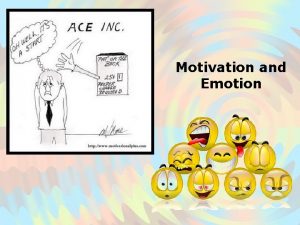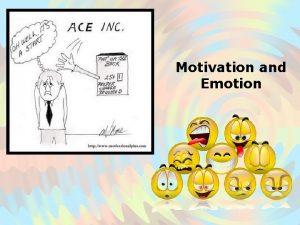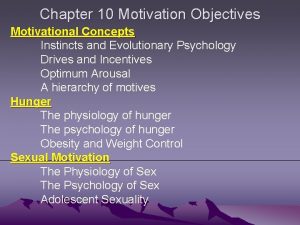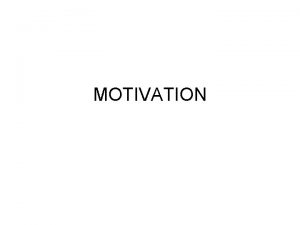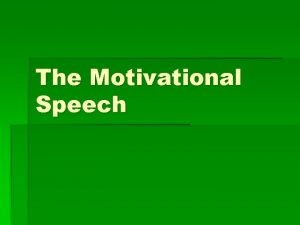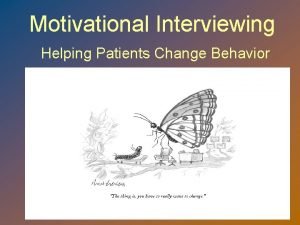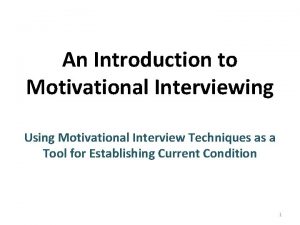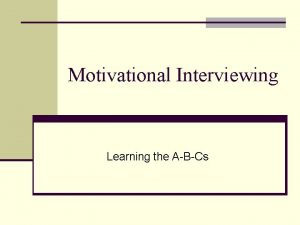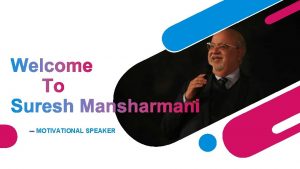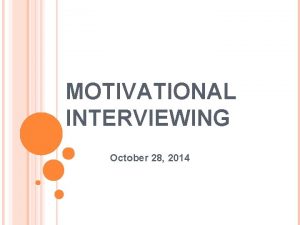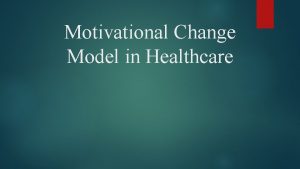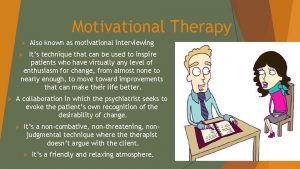Motivation and Work Motivational Concepts Motivation is the






























- Slides: 30

Motivation and Work

Motivational Concepts • Motivation is the energizing and directing of behavior, the force behind our yearning for food, our longing for sexual intimacy, our need to belong, and our desire to achieve. • The instinct/evolutionary perspective explores genetic influences on complex behaviors. Drivereduction theory explores how physiological needs create aroused tension states (drives) that direct us to satisfy those needs.

Same motive, different wiring • The more complex the nervous system, the more adaptable the organism. Both the people and the weaver bird satisfy their need for shelter in ways that reflect their inherited capacities. The people’s behavior is flexible; they can learn whatever skills they need to build a house. • The bird’s behavior pattern is fixed; it can build only this kind of nest.

Instincts and Evolutionary Psychology • Under Darwin’s influence, early theorists viewed behavior as controlled by biological forces, such as specific instincts. When it became clear that people were naming, not explaining, various behaviors by calling them instincts, this approach fell into disfavor. • The underlying idea—that genes predispose species-typical behavior—is, however, still influential in evolutionary psychology.

Drive-reduction theory • Drive-reduction motivation arises from homeostasis—an organism’s natural tendency to maintain a steady internal state. • Thus, if we are water deprived, our thirst drives us to drink and to restore the body’s normal state.

Drives and Incentives • Drive reduction theory states that most physiological needs create aroused psychological states, driving us to reduce or satisfy those needs. The aim of drive reduction is internal stability, or homeostasis. Thus, drive reduction motivates survival behaviors, such as eating and drinking. • Not only are we pushed by our internal drives, we are also pulled by external incentives. Depending on our personal experiences, some stimuli (for example, certain foods) will arouse our desires.

Driven by curiosity • Baby monkeys and young children are fascinated by things they’ve never handled before. • Their drive to explore the relatively unfamiliar is one of several motives that do not fill any immediate physiological need.

Optimum Arousal • Human motivation aims not to eliminate arousal but to seek optimum levels of arousal. Having all our biological needs satisfied, we feel driven to experience stimulation and we hunger for information. We are “infovores, ” say neuroscientists Irving Biederman and Edward Vessel, after identifying brain mechanisms that reward us for acquiring information. • Lacking stimulation, we feel bored and look for a way to increase arousal to some optimum level. However, with too much stimulation comes stress, and we then look for a way to decrease arousal.

A Hierarchy of Motives • Maslow’s hierarchy of needs expresses the idea that, until satisfied, some motives are more compelling than others. It indicates that physiological needs must first be met, then safety, followed by the need for belongingness and love, and finally, esteem needs. Once all of these are met, a person is motivated to meet the need for self-actualization. This order of needs is not universally fixed but it provides a framework for thinking about motivation. • Some needs take priority over others. At this moment, with your needs for air and water hopefully satisfied, other motives—such as your desire to achieve (discussed later in this chapter)—are energizing and directing your behavior.

Maslow’s hierarchy of needs Once our lower-level needs are met, we are prompted to satisfy our higher-level needs. For survivors of the disastrous 2007 Bangladeshi flood, such as this man carefully carrying his precious load of clean water, satisfying very basic needs for water, food, and safety become top priority.

Hunger • After dropping rapidly, their body weights eventually stabilized at about 25 percent below their starting weights. Especially dramatic were the psychological effects. Consistent with Maslow’s idea of a needs hierarchy, the men became food-obsessed. • They talked food. They daydreamed food. They collected recipes, read cookbooks, and feasted their eyes on delectable forbidden foods. Preoccupied with their unfulfilled basic need, they lost interest in sex and social activities.

Monitoring stomach contractions • Using this procedure, Washburn showed that stomach contractions (transmitted by the stomach balloon) accompany our feelings of hunger (indicated by a key press).

The Physiology of Hunger • The impact of psychological factors, such as challenging family settings and weight-obsessed societal pressures, on eating behavior is dramatic in people with anorexia nervosa, who keep themselves on near-starvation rations, and in those with bulimia nervosa, who binge and purge in secret. In the past half-century a dramatic increase in poor body image has coincided with a rise in eating disorders among women in Western cultures. • In addition to cultural pressures, low self-esteem and negative emotions (with a possible genetic component) seem to interact with stressful life experiences to produce anorexia and bulimia.

The hypothalamus • The hypothalamus (colored red) performs various body maintenance functions, including control of hunger. Blood vessels supply the hypothalamus, enabling it to respond to our current blood chemistry as well as to incoming neural information about the body’s state.

Eating Disorders • • Anorexia nervosa typically begins as a weight-loss diet. People with anorexia—usually adolescents and 3 out of 4 times females—drop significantly (typically 15 percent or more) below normal weight. Yet they feel fat, fear gaining weight, and remain obsessed with losing weight. About half of those with anorexia display a binge-purge-depression cycle. • • Bulimia nervosa may also be triggered by a weightloss diet, broken by gorging on forbidden foods. Bingepurge eaters—mostly women in their late teens or early twenties—eat the way some people with alcohol dependency drink—in spurts, sometimes influenced by friends who are bingeing.

Evidence for the brain’s control of eating • A lesion near the ventromedial area of the hypothalamus caused this rat’s weight to triple.

Body Chemistry and the Brain • Two distinct hypothalamic centers influence eating. Activity along the sides of the hypothalamus (the lateral hypothalamus) brings on hunger. If electrically stimulated there, well-fed animals begin to eat. (If the area is destroyed, even starving animals have no interest in food. ) Recent research helps explain this behavior. • When a rat is food-deprived, its blood sugar levels wane and the lateral hypothalamus churns out the hungertriggering hormone orexin. When given orexin, rats become ravenously hungry. Activity in the second center— the lower mid-hypothalamus (the ventromedial hypothalamus)—depresses hunger. Stimulate this area and an animal will stop eating; destroy it and the animal’s stomach and intestines will process food more rapidly, causing it to become extremely fat.


Obesity and Weight Control • The lack of exercise combined with the abundance of highcalorie food has led to increased rates of obesity, showing the influence of environment. Twin and adoption studies indicate that body weight is also genetically influenced (in the number of fat cells and basal metabolic rate). Thus, genes and environment interact to produce obesity. • Those wishing to lose weight are advised to make a lifelong change in habits, minimize exposure to tempting food cues, boost energy expenditure through exercise, eat healthy foods, space meals throughout the day, beware of the binge, and forgive the occasional lapse.

The appetite hormones • Insulin: Secreted by pancreas; controls blood glucose. • Leptin: Secreted by fat cells; when abundant, causes brain to increase metabolism and decrease hunger. • Orexin: Hunger-triggering hormone secreted by hypothalamus. • Ghrelin: Secreted by empty stomach; sends “I’m hungry” signals to the brain. • Obestatin: Secreted by stomach; sends out “I’m full” signals to the brain. • PYY: Digestive tract hormone; sends “I’m not hungry” signals to the brain.

Taste Preferences: Biology and Culture • Body chemistry and environmental factors together influence not only when we feel hungry, but also what we hunger for—our taste preferences. When feeling tense or depressed, do you crave starchy, carbohydrate-laden foods? Carbohydrates help boost levels of the neurotransmitter serotonin, which has calming effects. When stressed, even rats find it extra rewarding to scarf Oreos. • Our preferences for sweet and salty tastes are genetic and universal. Other taste preferences are conditioned, as when people given highly salted foods develop a liking for excess salt, or when people who have been sickened by a food develop an aversion to it.


A losing battle • Ryan Benson lost 122 pounds to win the first season of the TV reality show, “The Biggest Loser. ” • But then, like so many, he found maintaining the loss an even bigger challenge.

Motivation at Work • Personnel psychologists work with organizations to devise selection methods for new employees, recruit and evaluate applicants, design and evaluate training programs, identify people’s strengths, analyze job content, and appraise individual and organizational performance. • Subjective interviews foster the interviewer illusion; structured interviews pinpoint job-relevant strengths and are better predictors of performance. Checklists, graphic rating scales, and behavior rating scales are useful performance appraisal methods.

360 -degree feedback • With multisource 360 degree feedback, one’s knowledge, skills, and behaviors are rated by self and surrounding others. Professors, for example, may be rated by their department chairs, their students, and their colleagues. • After receiving all these ratings, professors discuss the 360 -degree feedback with their department chair.

Personnel Psychology/Harnessing Strengths • Personnel psychologists aim to identify people’s strengths and to match them with organizational tasks. Subjective interviews lead to quickly formed impressions, but they also frequently foster an illusory overconfidence in one’s ability to predict employee success. • Structured interviews, pinpointing job-relevant strengths, enhance interview reliability and validity. Personnel psychologists also assist organizations in appraisal that boosts organizations, motivates individuals, and is welcomed as fair.

Engaged employees facilitate organizational success • Best Buy’s 400 electronic goods stores have nearly identical product layout and operations manuals. Yet some stores have had much more engaged employees—and more profitable performance. • The store with the highest worker-engagement scores has been in the top tenth of stores in having profits beyond budget. And the store with the least-engaged employees has been in the bottom tenth.

On the right path • The Gallup Organization path to organizational success

Organizational Psychology: Motivating Achievement • People who excel are often self-disciplined individuals with strong achievement motivation. To motivate employees to achieve, smart managers aim to create an engaged, committed, satisfied workforce. • Effective leaders build on people’s strengths, work with them to set specific and challenging goals, and adapt their leadership style to their situation.

Positive coaching • Larry Brown, an adviser to “The Positive Coaching Alliance, ” has been observed during practices to offer his players 4 to 5 positive comments for every negative comment (Insana, 2005). • In 2004, his underdog Detroit Pistons won the National Basketball Association championship.
 Motivation from concepts to applications
Motivation from concepts to applications Chapter 7 organizational behavior
Chapter 7 organizational behavior Basic concepts of motivation
Basic concepts of motivation Motivation to learn an overview of contemporary theories
Motivation to learn an overview of contemporary theories Chapter 4 section 1 work and machines answer key
Chapter 4 section 1 work and machines answer key Motivational methods and programs
Motivational methods and programs 14 lcp principles
14 lcp principles Hát kết hợp bộ gõ cơ thể
Hát kết hợp bộ gõ cơ thể Ng-html
Ng-html Bổ thể
Bổ thể Tỉ lệ cơ thể trẻ em
Tỉ lệ cơ thể trẻ em Gấu đi như thế nào
Gấu đi như thế nào Tư thế worms-breton
Tư thế worms-breton Chúa yêu trần thế
Chúa yêu trần thế Môn thể thao bắt đầu bằng từ chạy
Môn thể thao bắt đầu bằng từ chạy Thế nào là hệ số cao nhất
Thế nào là hệ số cao nhất Các châu lục và đại dương trên thế giới
Các châu lục và đại dương trên thế giới Công thức tiính động năng
Công thức tiính động năng Trời xanh đây là của chúng ta thể thơ
Trời xanh đây là của chúng ta thể thơ Mật thư anh em như thể tay chân
Mật thư anh em như thể tay chân 101012 bằng
101012 bằng Phản ứng thế ankan
Phản ứng thế ankan Các châu lục và đại dương trên thế giới
Các châu lục và đại dương trên thế giới Thơ thất ngôn tứ tuyệt đường luật
Thơ thất ngôn tứ tuyệt đường luật Quá trình desamine hóa có thể tạo ra
Quá trình desamine hóa có thể tạo ra Một số thể thơ truyền thống
Một số thể thơ truyền thống Bàn tay mà dây bẩn
Bàn tay mà dây bẩn Vẽ hình chiếu vuông góc của vật thể sau
Vẽ hình chiếu vuông góc của vật thể sau Nguyên nhân của sự mỏi cơ sinh 8
Nguyên nhân của sự mỏi cơ sinh 8 đặc điểm cơ thể của người tối cổ
đặc điểm cơ thể của người tối cổ Giọng cùng tên là
Giọng cùng tên là
